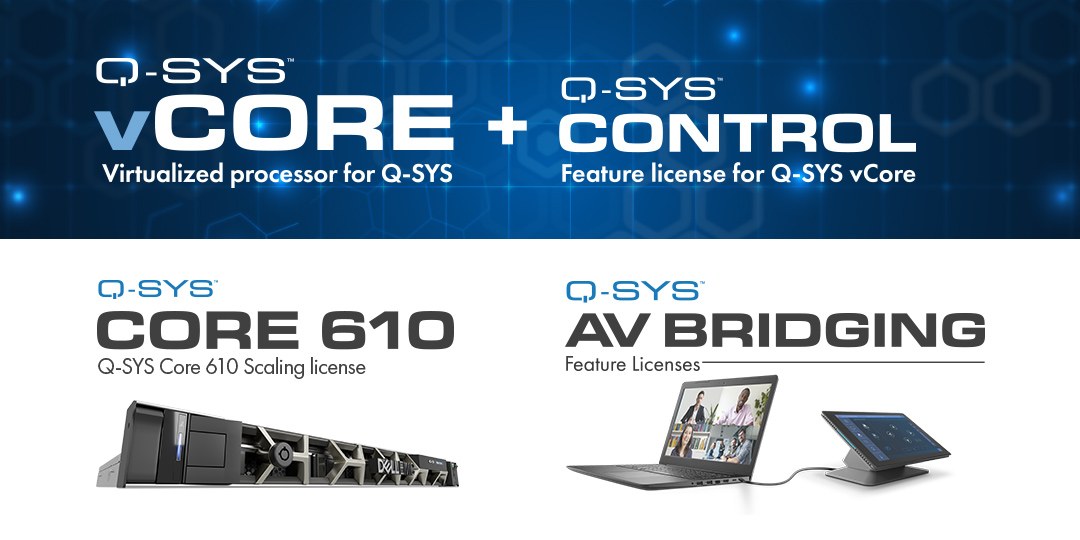
Next Evolution of Q-SYS Software-based Platform
Q-SYS software innovations, including virtualized Control processing, continue to drive enhanced customer experience through the Q-SYS OS
Costa Mesa, Calif. (September 21, 2022) – [De, Es, Fr] – Q-SYS is pleased to announce several new innovations to the Q-SYS audio, video and control Platform, expanding features and capabilities at the software level.
- Q-SYS vCore, the first virtualized processor for Q-SYS and the accompanying Q-SYS Control feature license for vCore, brings scalable Q-SYS Control capabilities directly to the users’ own compute devices.
- Q-SYS Core 610 network processor combines the Q-SYS OS with an enterprise-grade Dell server. For those installations that require even greater processing capacity, the Q-SYS Core 610 Scaling license scales key feature sets by 50 percent.
- Q-SYS AV Bridging feature license enables plug-and-play USB connectivity on the Q-SYS TSC Series Gen 3 touchscreen controllers.
“Ever since its inception in 2009, the history of the Q-SYS Platform has been forged through software innovation, starting with the industry’s first standards-based realtime audio, video and control (AV&C) Platform, and has continued to deliver features and capabilities at the software level,” says Jatan Shah, President and Chief Operating Officer, Q-SYS. “As Q-SYS enters the next evolution of the Platform and greater Ecosystem, we are elevating the role of software when it comes to specifying, building, and experiencing AV&C solutions. These latest innovations will also aid in reducing the industry’s supply chain challenges and continue to transcend the traditional limitation of bespoke hardware with the power of a robust, software-based AV&C Platform.”
Q-SYS vCore Virtualized Processor + Q-SYS Control Feature License for vCore
Q-SYS vCore virtualized processor presents a subset of scalable Q-SYS functionalities in a fully software-based format via a PC/server hypervisor. When paired with the new Q-SYS Control feature license, vCore allows integrators and end users to enlist their own compute devices to add Q-SYS Control capabilities to provide enhanced control, automation, UX capabilities, remote monitoring and helpdesk features to systems. This is ideal for less complicated systems that do not require dedicated Q-SYS audio or video functionality, or those features that are already fulfilled with standalone hardware, legacy audio-only DSP, as well as those that need to replace aging control systems.
Using the same modern, standards-based IT architecture as the rest of the Q-SYS processing portfolio, the vCore also utilizes the same Q-SYS Designer Software to build, design and deploy systems, allowing the ability to easily port Q-SYS control programming with minimal effort. This also empowers IT staff to standardize system control with access to Q-SYS Open, a toolkit of industry-standard protocols and open developer tools.
Additionally, the Q-SYS vCore plus Q-SYS Control feature license creates a bridge for those less complex rooms, that typically have disparate pieces of hardware, to enable cloud-based remote monitoring and management capabilities with Q-SYS Reflect Enterprise Manager.
Q-SYS Core 610 Processor
Following the innovation trajectory of the Q-SYS Core 5200 enterprise processor, the Q-SYS Core 610 processor combines the powerful Q-SYS OS with an enterprise-grade Dell commercial off-the-shelf (COTS) server delivering a flexible and scalable audio, video, and control solution to serve mid-tier applications that require high density channel counts. As a fully networked solution, the Core 610 allows users to centralize processing for multiple spaces or zones while distributing network I/O closer to the endpoints, for a more streamlined system design. This makes it equally suited for collaboration applications, as well as larger hospitality, entertainment, or transportation venues.
Integrators and end users can also take advantage of Q-SYS scaling and feature licenses, such as the new Q-SYS Core 610 Scaling license which broadly scales most capacities by 50 percent, including general purpose processing power, network I/O channels, AEC processing channels and more. This allows you to rightsize system capabilities at the software level.
AV Bridging Feature License
The Q-SYS AV Bridging feature license expands the functionality of the TSC Series Gen 3 network touchscreens, allowing the user to connect a PC via USB directly to the touchscreen controller to integrate Q-SYS audio and camera feeds for convenient BYOD/BYOM conferencing connectivity. By leveraging the power of the Q-SYS OS, users can simply enable UC platform connectivity without the need for any additional hardware or specialty drivers, saving time in configuration and installation as well as infrastructure costs.
Like all Q-SYS feature licenses, the AV Bridging license can be easily deployed remotely using Q-SYS Reflect Enterprise Manager.
For more information on the Q-SYS vCore and Q-SYS Control feature license for vCore, please visit: qsys.com/vcore. To learn about the Q-SYS Core 610 processor and feature license, please visit: qsys.com/core610. And, for more information on the Q-SYS AV Bridging feature license, please visit: qsys.com/avbridginglicense.
About Q-SYS
Make AV smarter. Q-SYS is a cloud-manageable audio, video and control (AV&C) Platform built around a modern, standards-based IT architecture. Since its inception in 2009, it has been architected to deliver personalized, connected and engaging AV experiences. With established solutions across corporate, education, hospitality, venues & events, cinema, government, healthcare, and transportation, Q-SYS redefines what is possible for live and virtual experiences by uniting hardware and software partners, developers, and creators.
For More Information
QSC Press Contact:
Kristine Fowler | Sr. Digital Marketing & Global Communications manager
714.624.4527 | Email: [email protected] | qsys.com
Press Contact (EMEA & South Asia):
Sandra Rothe
Media & PR Manager | Email: [email protected] | qsys.com